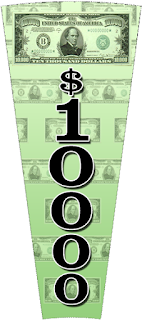
The Wheel of Fortune Mystery Wedge Problem is my attempt at a slightly more modern spin (pun intended) on the classic Monty Hall problem, which is a probability puzzle based on an older game show. Most modern American (and many international, so I’ve learned) TV viewers are likely familiar with Wheel of Fortune, but this specific problem can be framed in a way that doesn’t require complete knowledge of the rules of the game:
- You have X dollars in the bank and it’s your turn to spin the wheel
- You spin the wheel and land on the $10,000 Mystery Wedge, make a correct guess to win Y dollars, and Pat Sajak, the host, then offers you two options:
- The first option is to do nothing. It is still your turn and you will end up with X + Y dollars in the bank.
- The second option is to flip over the Mystery Wedge for a 50/50 shot at winning $10,000. If you lose, you lose all your money plus your turn.
Should you flip over the Mystery Wedge or not? At what values of X and Y should you flip the wedge and take the risk?
A quick calculation might suggest that $5,000 is the break-even point, since the probability of winning multiplied by the winnings is $5,000. From that reasoning, the amount you can end the turn with needs to be less than $5,000 (X + Y < 5000) in order to justify flipping over the Mystery Wedge.
However, a more detailed calculation of the expected value of the wager reveals a different conclusion. The expected value of the wager is 0.5 * 10000 - 0.5 * (X + Y). If the amount you can end the turn with is $5,000 (X + Y = 5000), the expected value of the wager is actually +$2,500, which is an advantageous wager you should take. This suggests that the break-even point is actually $10,000, and that you should always flip over the Mystery Wedge if the amount you can end the turn with (amount in your bank plus what you just won by guessing letters) is less than that.
Perhaps a more intuitive approach is to consider the odds versus the payout. With the option of a guaranteed $5,000, you are being offered a wager to win twice your money, which is a 2:1 payout at 1:1 odds (50%), a favorable wager. At $10,000, the payout and odds are both 1:1, which is the aforementioned break-even point.
However, the fun doesn’t end there. One subtle but important consequence of flipping over the Mystery Wedge is that, should you lose, you not only lose all your money but you also lose your turn. That is, you don’t actually end up with $0 and the chance to spin the wheel again, which is unaccounted for in the expected value calculation. If you expect to win Z dollars after retaining your turn, then Z needs to be factored into the amount at risk in the wager.
Comments